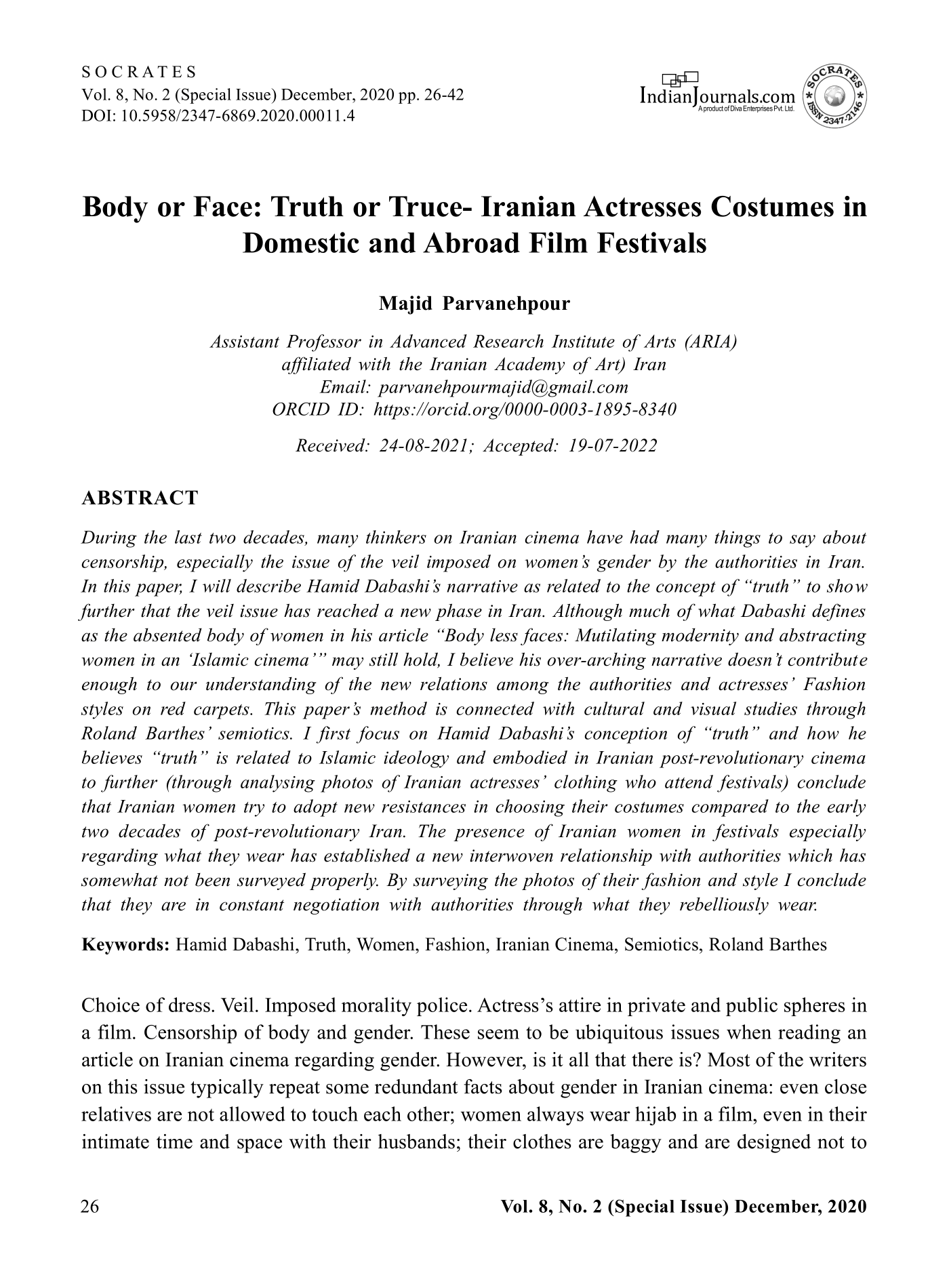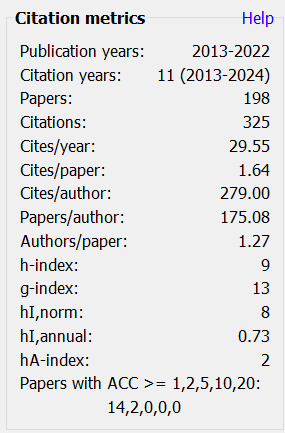Body or Face
Truth or Truce- Iranian Actresses Costumes in Domestic and Abroad Film Festivals
DOI:
https://doi.org/10.5958/2347-6869.2020.00011.4Keywords:
Hamid Dabashi, truth, women, Fashion, Iranian cinema, semiotics, Roland BarthesAbstract
During the last two decades, many thinkers on Iranian cinema have had many things to say about censorship, especially the issue of the veil imposed on women’s gender by the authorities in Iran.
In this paper, I will describe Hamid Dabashi’s narrative as related to the concept of “truth” to show further that the veil issue has reached a new phase in Iran. Although much of what Dabashi defines as the absented body of women in his article “Body less faces: Mutilating modernity and abstracting women in an ‘Islamic cinema’” may still hold, I believe his over-arching narrative doesn’t contribute enough to our understanding of the new relations among the authorities and actresses’ Fashion styles on red carpets. This paper’s method is connected with cultural and visual studies through Roland Barthes’ semiotics. I first focus on Hamid Dabashi’s conception of “truth” and how he believes “truth” is related to Islamic ideology and embodied in Iranian post-revolutionary cinema to further (through analysing photos of Iranian actresses’ clothing who attend festivals) conclude that Iranian women try to adopt new resistances in choosing their costumes compared to the early two decades of post-revolutionary Iran. The presence of Iranian women in festivals especially regarding what they wear has established a new interwoven relationship with authorities which has somewhat not been surveyed properly. By surveying the photos of their fashion and style I conclude that they are in constant negotiation with authorities through what they rebelliously wear.
Downloads
Metrics
References
Barthes, Roland (1990). The Fashion System, trans. by Matthew Ward & Richard Howard, California, University of California Press
Bouvier, Gwen (2016). Discourse in clothing: The social semiotics of modesty and chic in hijab fashion. Gender and Language, 10(3), 364-385.
Dabashi, Hamid (1998). Body less faces: Mutilating modernity and abstracting women in an ‘Islamic cinema. Visual Anthropology, 10(2-4), 361-380
Dabashi, Hamid (2000). In the Absence of Face. Social Research, 67(1), Faces (Spring 2000), pp. 127-185.
Hunt, Lynn (ed.) (1991). The Eroticism and the Body Politic. Baltimore: The Johns Hopkins University Press.
Mernissi, Fatima (1992). The Veil and The Male Elite: A Feminist Interpretation of Women’s Rights in Islam, trans. by Mary Jo Lakeland, Perseus Books Publishing, USA
Naficy, Hamid (1991). The Averted Gaze in Iranian Postrevolutionary Cinema. Public Culture, 3(2), 29-40.
Naficy, Hamid (2012). A Social History of Iranian Cinema, Vol. 4: The Globalizing Era, 1984-2012, Durham: Duke University Press.
Rahbaran, Shiva (2016). Iranian Cinema Uncensored: Contemporary Film-Makers Since the Islamic Revolution, London, I.B. Tauris.
Schuon, Frithjof (2016). Sufism: Veil and Quintessence, A New Translation with Selected Letters, trans. by Mark Perry, Jean-Pierre Lafouge and Hames S. Cutsinger, ed. by James S. Cutsinger, Bloomington, Indiana, World Wisdom Books.
Shirazi, Faegheh (2019). The Veiling Issue in 20th Century Iran in Fashion and Society, Religion, and Government. Religions, 10(8), 461
Tapper, Richard (ed.) (2002). The New Iranian Cinema: Politics, Representation, and Identity, London: I.B. Tauris.
The Clear Quran: A Thematic English Translation (2015), trans. Mustafa Khattab
Wise, Christopher (2009). Derrida, Africa, and the Middle East, Palgrave Macmillan, New York.
Zahedi, Ashraf (2007). Contested Meaning of the Veil and Political Ideologies of Iranian Regimes. Journal of Middle East Women’s Studies, 3(3) (Fall 2007), 75-98.

Downloads
Published
How to Cite
Issue
Section
Categories
License
Copyright (c) 2022 Majid Parvanehpour (Author)

This work is licensed under a Creative Commons Attribution-NonCommercial 4.0 International License.
Revised Copyright/CC license that applies to all the articles published after 05-02-2017
Attribution-NonCommercial 4.0 International (CC BY-NC 4.0)

Copyright/CC license that applies to all the articles published before 05-02-2017
Attribution-Non Commercial-No Derivatives 4.0 International (CC BY-NC-ND 4.0)

Author(s) will retain all the right except commercial and re-publishing rights. In the case of re-publishing, they will have to obtain written permission from the journal. Additional licensing agreements (Creative Commons licenses) grants rights to readers to copy, distribute, display and perform the work as long as you give the original author(s) credit, they can not use the works for commercial purposes and are not allowed to alter, transform, or build upon the work. For any reuse or distribution, readers and users must make clear to others the license terms of this work. Any of these conditions can be waived if you get permission from the copyright holders. Nothing in this license impairs or restricts the authors’ rights. To view a copy of this license, visit http://creativecommons.org/licenses/by-nc-nd/4.0/ or send a letter to Creative Commons, 171 Second Street, Suite 300, San Francisco, California, 94105, USA.
Research Papers published in SOCRATES are licensed under an Attribution-NonCommercial-NoDerivatives 4.0 International (CC BY-NC-ND 4.0)
















